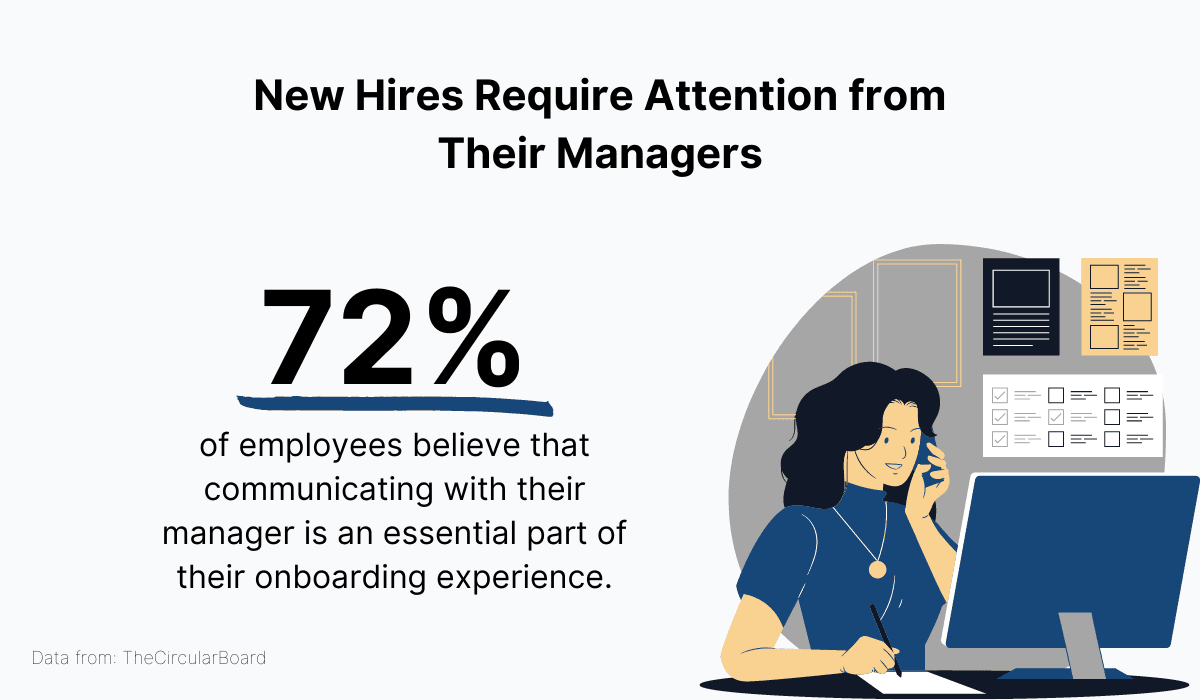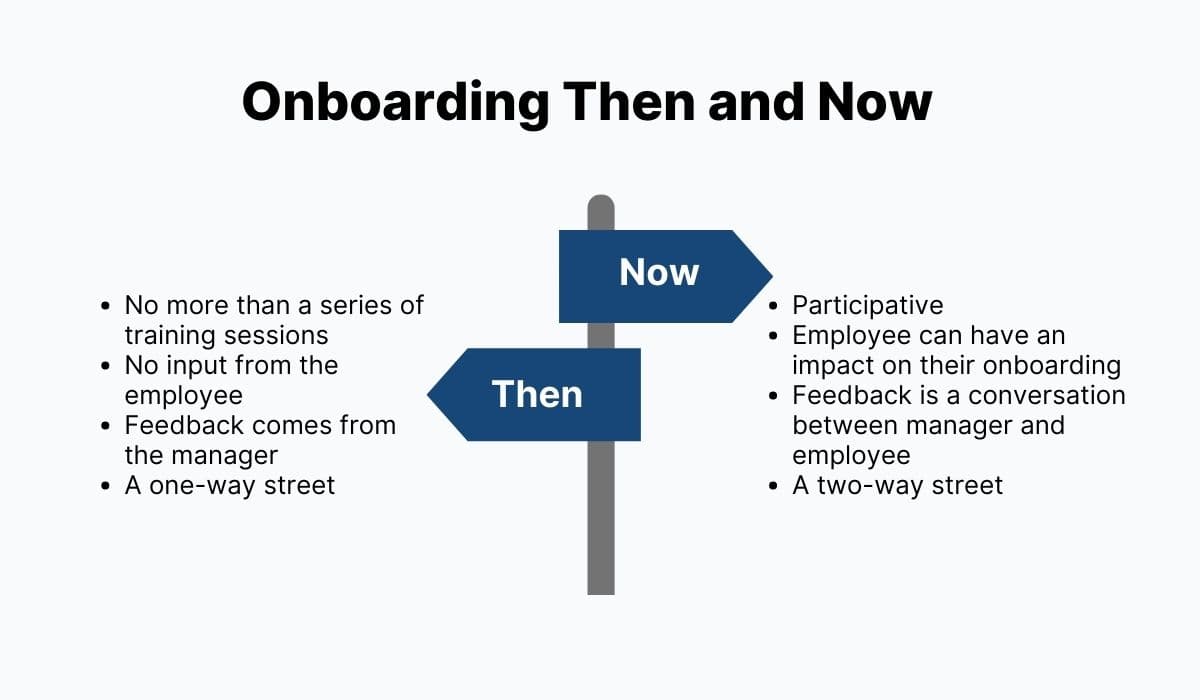Keeping new hires engaged throughout the onboarding process is a challenge no company is immune to.
After all, starting a new job is an emotional rollercoaster of both positive and negative experiences. Every new employee needs to go through these challenges and come out as a winner.
This article will help you support your new teammates during this sensitive period, so you can make sure they remain motivated and committed until they are ready to start working independently.
Let’s start right at the beginning, with the new hire’s first day at the office.
Make Them Feel Special From Day One
The easiest way to elevate someone’s mood and motivate them to do their best work is to make them feel special and give them attention.
You definitely already know this from your personal life, but it also holds true for your employee onboarding process.
In fact, sometimes just a small sign of appreciation can have an incredible effect on your team’s engagement levels, and that’s a proven fact!

Source: Archbee.com
This power of kindness is something many high-achieving companies recognize and regularly use in their onboarding processes. They make sure their new hires feel validated for choosing to work for that company.
Let’s look at a real-life example.
If your new hire is set to start working at your office, then you could take a leaf out of DoubleDutch’s book. They’re an event technology company which recently merged with CVent.

Source: Pinterest
Not only is the new employee welcomed with some awesome company swag, but an atmosphere of celebration is achieved with some balloons and cookies.
Those serve as a callsign for colleagues to come over and introduce themselves. If the rookie isn’t at their desk when they come by, they can also leave a short welcome note.
This is a great way to make the new hire feel special on their first day, but it also goes a long way to facilitate connection building and networking.
Those are always a challenge when starting a new job.
Here at Archbee, we do realize that the pandemic has meant that a lot of offices have closed down in favor of remote work, but that doesn’t mean you can’t put together a welcome kit for your new hires.
👉And here’s a pro tip: since the employee will be working from home, you can send them a get-to-know-you survey and ask them about their preferred tech and general needs during working hours.
After you get their answers, you can delight them by equipping them with everything they could want to start working remotely!
Employees really appreciate this kind of attention to detail, and it will definitely go a long way to make an excellent first impression.
But your efforts shouldn’t stop there. Here are some other things employees are saying they would be very happy to receive when starting a remote job.

Source: TalentLMS
So if sending a welcome kit is inconvenient at the moment, why not surprise them with a streaming service subscription or an online training course of their choice?
Remember, showing your new hire you value them from day one is a great way to help them validate their decision to come work for you.
Knock them off their feet with a nice gesture, and they’re sure to return the favor by showing you why you took them on in the first place.
Communicate Your Company’s Values and Purpose
New hires need a good sense of how important they are to the company to feel excited and committed to their work.
If you don’t provide them with a sense of purpose, they may quickly become bored and even leave your company very soon after joining it.
This is a bigger problem than you may even realize. In today’s corporate world, most workers say they feel disengaged at work.

Source: Archbee.com
If you’re noticing your new employees are losing steam quickly, it may be because they’re failing to find meaning behind their work.
When that happens, try to reinforce your onboarding process in a way that conveys how this employee’s role ties into the company mission.
The absolute best way to do this is through conversation.
It’s a great idea to sit down with the employee from time to time and talk about the results of their labor and how they have helped the entire company come one step closer to achieving an important goal.
For example, if your new hire works in customer service and they had a great call with a customer, it can make a huge difference if you take the time out of your day to praise their good work.
Explain that excellent customer service is one of the highest values of your organization, and the employee will be sure to take pride in their work and continue to put their best foot forward.
It’s also a good idea to have new employees meet the CEO at some point during onboarding.
After all, who better to explain the company mission and main goals than the person who created them in the first place?
According to Netflix's Poorna Udupi, that’s exactly what the company’s CEO, Reed Hastings does.
When new employees join the company, he makes sure to take time out of his schedule to get to know them in a group meeting.

Source: Engadget
And if Netflix’s CEO has time to communicate company goals and values, we’re sure other CEOs can too.
A company’s goals and mission can be read from any “about” page. However, it’s much more difficult to connect every role and job at the company to these crucial values.
Therefore, it’s your responsibility to have that conversation with your new employees and help them understand how they’re helping advance the company.
With a clearer understanding of the impact of their role, your employees are bound to feel more connected and committed to their work.
Provide a Clear Onboarding Roadmap
Along with a fuzzy idea of their purpose in the company, a messy onboarding program that doesn’t really lead anywhere is another potential source of disengagement for workers.
Without a clear onboarding roadmap, employees can come to feel lost, laboring under the impression that they're not progressing enough on their way to becoming valued members of the team.
On the other hand, providing a clear structure to the onboarding process and building a roadmap to success gives employees a good idea of how they should be advancing and what the checkpoints on the way are.
This is something that more than half of the companies out there are still getting wrong because they’re not building their onboarding process around goals and milestones.

Source: Archbee.com
An onboarding roadmap doesn’t have to be immensely complex to be effective at keeping the new hire engaged.
Quite to the contrary, it works best when it just outlines how the employee’s time at the company is going to look during the various phases of the onboarding process and what the agreed-upon metrics for success in every phase are.
For example, engineers at Zapier are onboarded in three phases.
The first week is dedicated to meeting the team, learning about the company’s systems, and getting acquainted with the different departments and engineering teams within the company.

Source: Zapier
During the second week, they start tackling smaller tasks.
If they complete these successfully (a concrete goal for new hires to work toward), they can move on to the final phase, where they collaborate with other teams on cross-functional projects.
A cool feature of Zapier’s onboarding process is that new employees who manage to successfully navigate these phases are flown to California.
There, they get to meet and work with their teammates in person, at a nice Airbnb rented for that purpose. This is crucial for relationship building, since Zapier’s team works remotely.

Source: Zapier
Zapier owes a part of its success to giving their new employees direction and milestones they can hold on to. Their onboarding process has a clear-cut roadmap recent hires can follow and never feel lost.
And that’s a great lesson to learn. As long as your employees know they’re heading in the right direction, they’ll never feel lost or disengaged.
Get Managers Involved in Onboarding
An important question related to onboarding is the question of ownership.
Who’s responsible for the new employee’s training and assimilation? Who can they turn to for feedback and questions?
If the new employees are left to their own devices, they will quickly develop anxiety and start finding work stressful. That’s why a mentor figure, such as the employee’s manager, is so central to the onboarding process.
Employees themselves are calling for more attention from their managers so that they can navigate onboarding more successfully.

Source: Archbee.com
This, of course, holds true for the new employee’s direct supervisor.
They should be the one to come up with the tasks for the new hire, as well as communicate expectations and set goals so that the new employee has a very clear idea of what their job entails.
In addition to that, a good relationship with the manager can also go a long way to give the employee a clear understanding of what it takes to succeed at their new company.
But it doesn’t stop there.
For best results, you can also involve the managers and team leaders across the company to present their departments and help build a strong foundation for future collaboration.
That’s what Greenhouse, the successful recruiting company, does. During onboarding, department heads from sales, customer success, and other teams present their departments to new hires and demonstrate their procedures as they would to a customer.

Source: Glassdoor
By interconnecting in this way, the team has been able to preserve the feel of a small company, even though they’ve been growing steadily and can now boast a staff of 215 people.
Cheryl Roubian, Director of Talent Management at Greenhouse, is very happy with this onboarding process she’s helped to implement:
“This gives new hires exposure to and context around what other people in the company are working on, prioritizing, and delivering. It’s a lot easier to work with someone else when you understand their needs up front.”
Greenhouse presents us with a prime example of how managers hold a key responsibility in the onboarding process.
To help keep your employees engaged in their early days with your company, try to use the power these figures can bring to employee onboarding.
Make Feedback a Two-Way Street
As you may have noticed, a major theme running through this entire article is the notion that onboarding isn’t synonymous with training.
In other words, onboarding isn’t a one-way street where you instruct, and the new employee learns passively.
This may have been the methodology of employee induction in the past. However, the corporate world has left that approach behind precisely because it was creating disengaged team members whose voice was never heard and whose commitment to their company was lax at best.

Source: Archbee.com
The new and improved onboarding process is a two-way street.
Employees are given a say to make sure their talents are put to good use, and that work processes are compatible with their needs and personal style.
Nowhere is this more visible than in the aspect of giving and receiving feedback.
Modern managers are often encouraged not just to offer feedback, but also to seek it out from their employees as often as they can.
That’s because employee feedback gives new hires a sense of control over their own onboarding process. Additionally, it calls your attention to aspects of the process that can be improved.
This, of course, makes your onboarding process more appealing.
In fact, according to research, making feedback a conversation instead of a monologue can make your onboarding process twice as engaging.

Source: Archbee.com
So, the next time you’re having a feedback session with a new employee, take a minute to ask them about the onboarding process from their perspective.
There’s so much you can learn if you ask questions like:
- How is the onboarding process serving you?
- Is there anything about this job you’d like to change?
- Do you have everything you need to do your best work?
- Are you getting along with the rest of your team?
Remember, to make your onboarding process more engaging in just one step, flip the conversation from “We’re going to give you this” to “Tell us what we can give you.”
Celebrate Successes
We’ve already covered the importance of setting up goals and milestones for new employees, so let’s develop this great practice a bit more.
The ultimate way to increase engagement during the onboarding process is to reinforce goals and milestones by celebrating a job well done.
This sends a clear message to employees that their work is valued.
It lets them know that you’re definitely aware of the effort they’re putting into completing the onboarding process, and motivates them to keep doing their best work.
There are many ways to celebrate success, so don’t be afraid to experiment and find what works best within your organization.
A great place to start is to make it a habit to give praise to employees who are excelling in their tasks and meeting the expectations you’ve set for them.
Here are some tips on how to do that effectively.

Source: Archbee.com
To sum up, effective praise is timely, personal, sincere, and tied to specific company goals. Most importantly, it’s given regularly.
Alternatively, you can put a rewards system in place. This is a big part of gamification in the workplace, which is a huge trend in onboarding right now.
Rewarding stellar service or a job well done reinforces the notion that hard work is valued at your company.
The best part is that you don’t even have to go all out with a big rewards budget. Even a small token of appreciation will make a big difference.
For example, at Zappos, an online shoe retailer famous for its company culture, employees who volunteer to help their colleagues or participate in training programs stand to earn Zollars.
Those can be exchanged for company swag, such as gym bags, water bottles, or desk fans sold at the company Zollar Store.
Employees at the company love the program, and it’s been a cherished tradition for more than ten years.
As a manager, you should always be aware that positive reinforcement is one of the most powerful tools at your disposal for nailing employee engagement at your company.
With that in mind, keep seeking out ways to celebrate employee success, during onboarding and after, to build an unstoppable workforce that will propel your company forward.
We let you with two read recommendation before conclusion:
1. How to Write a Great Welcome to The Team Email
2. 15 Inspirational Welcome Messages for Your New Employees
Conclusion
And there you have it. Engaging employees during the onboarding period is a challenge that can be overcome easily, as long as you keep paying attention to your new hires during the onboarding process.
Make them feel valued and integral to the team, support them in their work, listen to their needs and celebrate their success.
By following these steps, you’re effectively getting rid of all of the biggest causes of disengagement in the workplace.
This makes way for a productive, happy, and capable staff that’s going to overcome every obstacle on your way to achieving your company goals.
FAQ
Frequently Asked Questions
Start with a thoughtful, personal welcome and remove first-day friction. Prepare their workspace or remote setup in advance, include a short handwritten note, and send a curated welcome kit (company swag, helpful tools, or a small perk like a streaming subscription). Share a clear first-day agenda, introduce a buddy, and encourage teammates to drop by or leave quick welcome messages. For remote hires, send a brief get-to-know-you survey ahead of time so you can tailor equipment, software access, and preferences (e.g., preferred laptop, work style). These small touches signal, “We’re ready for you—and we’re glad you’re here.”



